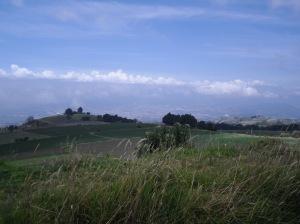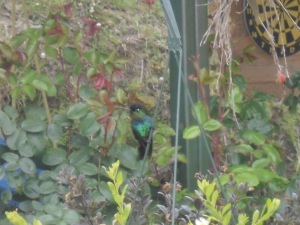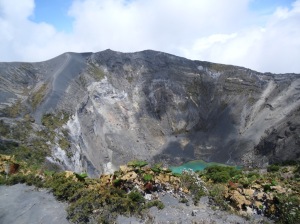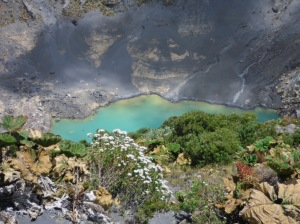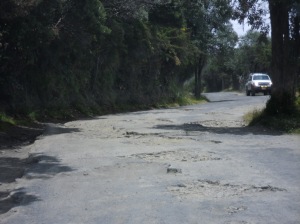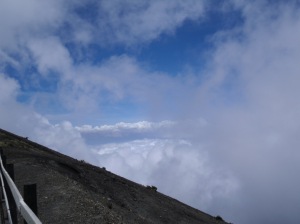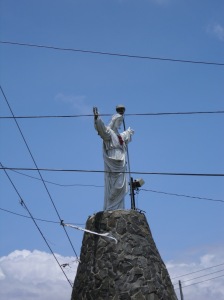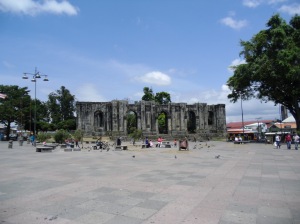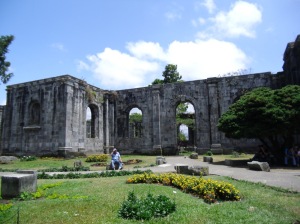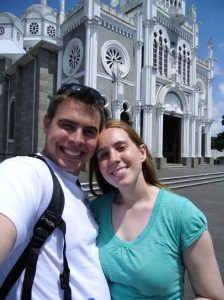*** Check out the first post of our trip to Costa Rica and read them in order! ***
Our last day in Costa Rica began early, since we planned on visiting a volcano and wanted to get to the summit before the weather could turn bad. Breakfast consisted of granola bars and plans to find a panadería later in the morning. On our way out of the hotel, we stopped at the front desk to get directions to Cartago, which is the city at the base of Volcan Irazú. We received detailed instructions from the man at the desk, complete with annotations on a map, and set off for a day of exploration!
Our hotel is on the west side of San Jose, but Cartago is located about 25 km to the east. Therefore, we had to traverse across San Jose with morning traffic before making it to the highway. Fortunately, we were a bit later in the day (8:30am) than the worst traffic and there were fewer cars than normal because of Holy Week.
We made it out of town without incident, though Philip’s tension levels were definitely a bit higher after navigating the disaster that is driving through San Jose. On the outskirts of town, we stopped at an ATM and got enough Colones to last us for the rest of our trip and to cover our cab ride to the airport the next day. We made it to Cartago without incident and the directions we had received were excellent.
Our route took us across the north side of Cartago before turning and heading up the slope to the summit of Volcan Irazú, which is over 11,000 feet high at its summit. We stopped at a gas station to fill up our tank and get our windshield cleaned, since it was absolutely filthy from all of our driving. Furthermore, we had been unable to clean the windshield on our own due to our missing wiper blade (read the post of our drive from San Jose to La Fortuna if you missed that story). We spent over 10 minutes at the gas station, but it was a fun experience and the attendant even directed us to an auto parts store (think Checkers) across the street where we could purchase a new wiper blade to replace our missing one.
Rather than deal with the wiper blade at the time, we decided to press on to the volcano and we followed the surprisingly plentiful signs pointing us on our way. The drive up was beautiful, though a bit hazy, with workers tending extremely steep fields by hand and the air temperature dropping every minute. The summit of Volcan Irazú is typically above the cloud level, so we had some harrowing moments of near white out as we drove through a cloud on our way up.
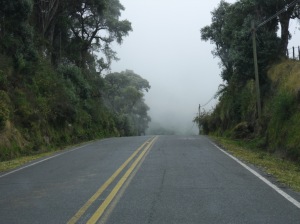
As we climbed higher up the volcano, we drove straight into a cloud and visibilty was only a few feet.
We stopped at a small restaurant and tourist information place on the way to use the restrooms. Inside, we saw our first fireplace since coming to Costa Rica and the warmth from the crackling fire was actually really nice. After thanking the two ladies inside, we walked back out and Rose spotted two bright green hummingbirds flitting about on a nearby tree. She took several pictures of the beautiful birds and we then returned to the car to complete the journey to the top of the volcano.
There is a ticket booth at the entrance to the national park and we arrived at it to find a line of 6 cars and a tour bus in front of us. The process of them getting tickets was painfully slow and we were starting to get frustrated with the inefficiency by the time we pulled up to the ticket window. The lady inside spoke excellent English and spent a few minutes showing us a map of the park and explaining where to go. She also warned us that upon leaving the park, we should not deviate from the main road until we had reached the large Jesus Christ statue, which was pretty low on the mountain. However, her exact words were the “white Jesus Christ”, and thankfully Rose had seen the statue on our way up and so knew what she was talking about. The lady warned us that if we took other roads, it was possible that we would be robbed, so not wanting to tempt fate, we planned on following her instructions when we left the park.
We drove a few hundred meters and parked near the small cafeteria and restrooms in the parking area. The walk to see the crater took about 30 minutes round trip, though mostly because we walked slowly as we looked around. The volcano has two main craters that we could see, and our path took us along the side of a large ash plain that was probably created when the volcano last erupted in the 1960s. The second crater is by far the coolest, because it contains a green lake in the center. Unfortunately, it was difficult to find a very good view of the lake and we had to climb up on the first rail of the safety fence in order to get any pictures at all.
Seeing so many volcanoes has been a neat experience and they really demonstrate how much power and energy is stored in the Earth. The desolate environments, billowing steam, and scarred earth is quite eye-opening. It also makes one wonder why people live so close to the volcano despite its history. That said, volcanic soil is supposedly very fertile so perhaps living with the danger of an eruption is just the way it goes in regions like this.
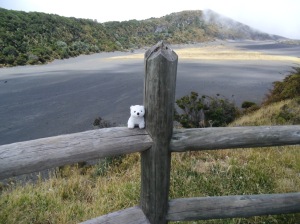
The ash plain adjacent to the craters on Volcan Irazu. Also, this is possibly the highest altitude ever achieved by a polar bear in Costa Rica!
After looping back around to the parking area, we went inside the cafeteria to see if we could get a quick snack to tide us over until we could find a true panadería. We expected the prices to be exorbitant, but were pleasantly surprised when we had two large empanadas (one with chicken and one with beef) for fewer than four dollars. We ate while sitting at a picnic table out front and then returned to our car.
We drove up the volcano a bit further to an overlook that we hoped would give better views of the crater (it really didn’t). The road is not maintained by the park (according to a posted sign), and the potholes are absolutely ridiculous. We drove slowly and made it to the top, where a large antenna tower is located. There is also an interesting structure at the top that we think was supposed to be a restaurant or something similar, but now just sits there. A sign indicated that it was restored by L.L. Bean. Although we couldn’t get any better pictures of the green lake, we were able to see across the tops of some of the clouds, which is a unique experience when your feet are on solid ground instead of in an airplane.
The return trip down the volcano was mostly uneventful, though it got scary when we had to again pass through a layer of cloud and visibility decreased to essentially nil. We passed the Jesus statue and Rose got us back to our earlier gas station. We decided that now was a good time to replace the windshield wiper and so we stopped at the auto parts store across the street.
We quickly learned that none of the workers spoke English, so Philip did his best to explain what we needed in Spanish. Through pointing at wiper blades on the wall, we got the point across and the man came out to measure our windshield so as to get the proper blade. We paid a shockingly low 1000 Colones (roughly two dollars) for our new wiper blade and went out to the car to install it. After watching us two engineers struggle to put on the wiper blade for a few minutes, the man came out from the store and put it in place in less than 30 seconds (to the untrained person, wiper blade installation is a tricky process!). We thanked him profusely for his help and drove down into the city of Cartago to find some food and check out two of the city’s churches.
Cartago is the former capital of Costa Rica, and is still the religious center of the country. San Jose only became the national capital recently (we think in 1974), after Cartago began to wane from a series of earthquakes and the eruption of Volcan Irazú. We had no map of the city, so we just drove towards what we thought was the center of town until we spotted a panadería that looked promising. We pulled into a parking lot, but realized that it was bank parking only. An attendant pointed us across the street to a public parking area, so we went there instead.
This was the first time we had to park in the Costa Rican equivalent of a pay-to-park garage, and it was a fun experience. The worker helped direct us as we backed into a narrow parking spot. We figured out that we would pay when we returned and took our parking card with hand-written time of arrival with us for our walk around town.
From the panadería, we got two small pizzas (ham and cheese of course), a chile cheese churro-looking thing, and a loaf of bread with sweet cream cheese inside and sugar crystals on top. We sat on the steps of a nearby church to eat our meal, but didn’t actually go inside since it was fairly simple and not on our list of places to see. Due to Rose’s amazing navigation abilities, we were actually only one block from the town’s center square, and we walked there after finishing our pizzas.
Our guidebook describes Cartago’s central square as “stark”, which is very accurate. At the very center, though, are the ruins of a church that was built in the 1500s. It was destroyed five times by earthquakes before they finally gave up on rebuilding it. We walked around the building and took many pictures of it. It was odd looking inside the walls, where rather than marble floors and pews, we found a nicely cared for flower garden instead.
Once content with our time at the ruined church, we set off for the main cathedral of Cartago, which Rose had fortunately spotted in the distance. It took a while to walk the many blocks to Basilica de Nuestra Señora de los Angeles, but we were not disappointed by its beauty when we arrived. Rather than the typical cross shape of most Roman-influenced churches, this one has a more Greek or Byzantine influence and has the cupola at the center of the building rather than over the altar. The inside is covered with lots of beautiful wood paneling and the effect is very nice.
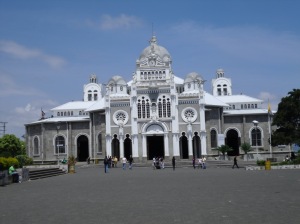
The Basilica di Nuestra Senora de los Angeles has the most beautiful facade of any of the churches we have seen in Costa Rica.
While inside the church, we saw several men painting some of the columns. We aren’t sure if this was the first time they had been painted or if this was restoration work (in Italy, it was safe to assume that any church work was restoration but the churches in Costa Rica tend to be much newer). We also witnessed a few people get down on their knees at the entrance to the church and crawl on them all the way to the altar. Two little girls were there with what we assume are their mother and grandmother, and we could tell that they really didn’t understand why they were doing it as they kept shuffling ahead and then turning around and coming back to their family with huge smiles on their faces.
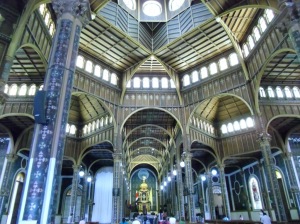
Costa Rica is renowned for its woodwork, as evidenced by the wood paneling gracing the interior of the basilica.
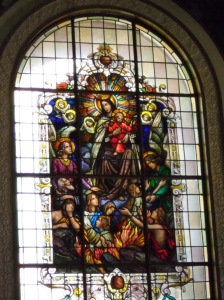
A stained glass window inside the basilica. We particularly like how the art does not cover the entire window, thus allowing more light into the church and helping to set the art apart with a border of light.
When we left the church, we walked around the side and followed signs to the “Piedra de Helzgada” although we didn’t know what that actually meant. The path led us around the back of the building where we found a small museum area displaying many medallions and pins, as well as a cutaway section showing the concrete and rock from different years of cathedral construction. The highlight of the area, though, is a painting/full-scale diorama depicting the story of the church’s founding (statue of the Virgin repeatedly disappearing from locked areas and reappearing on a stone in the forest…the cathedral is built on that spot).
Next to the museum area is a natural spring that is supposed to have healing properties. Many people were there filling up jugs or bottles with the water, and a nearby vendor even sold bottles (though they were closed). We elected not to partake of the water since we couldn’t be sure of its purity and had no desire to get sick on the last day of our vacation.
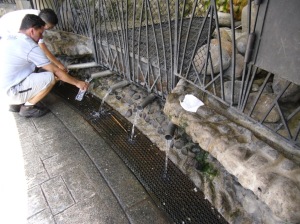
People filling up bottles of water at the natural spring beneath the basilica. The water is said to have healing properties.
We made the trip back to our car and paid the 950 Colones for our hour and a half or so of parking. Our next destination was the Orosi valley, an area outside of Cartago that is supposed to have stunning views and quaint little towns. Unfortunately, we really could have used a map of the city, and we quickly found ourselves driving on the wrong road heading into the hills.
We stopped at a bar a few kilometers down the road and Philip went inside to ask for directions. The bartended explained, though only in Spanish, that we needed to go back to the center of Cartago and go further east. “Always turn right”, he said, which turned out to be generally true but not in a way that was useful enough for navigating the ridiculously convoluted city. We came back into town and spent the next hour or so driving around trying to find the proper exit from Cartago to take us to our destination.
After becoming extremely frustrated and driving through smoke (burning the ditches next to the road), potholes, and some not-so-great-looking neighborhoods, we thought we had finally found the right road to take us east out of the city and to the Orosi valley. As we drove, it felt better and better…at least until we reached the rock quarry with enormous piping and equipment spanning the road. We drove past, but the road quickly turned to dirt and we knew that we were not where we need to be.
We turned around and asked the security guard at the quarry for directions to Paraiso, the first city in the valley. He explained in rapid Spanish that we had to go back to the center of town and go even further east. We thanked him, but by this point we were ready to give up and go back to our hotel. We navigated back through Cartago traffic and made it easily to the highway to take us back to San Jose. Apparently, we were not supposed to see the Orosi valley. Alternately, perhaps it does not actually exist and is merely a legend to delay and frustrate eager travelers. We may never know.
We returned to the hotel and cleaned out the car since we would have to return it soon. After dropping our stuff in our room and recovering for a few minutes, we went down to the front desk to ask for help with calling the rental car company to come pick up the vehicle (we would have to go to the airport before they opened the next day so, when we picked up the rental car, they offered to come get it for us instead). We also printed our boarding passes for the flight and had the lady schedule us a cab to help ease our time in the morning. After one last check of the car, we gave the keys to the lady at the desk and set off into town to find one last panadería, since we wouldn’t be able to get breakfast in the morning.
Our original thought was to go to a panadería just down the road from the hotel, but after looking at their offerings and remembering their indifference last time we were there, we decided to walk a bit further in search of another one. After a few blocks, we came to another panadería and had a fantastic time conversing with the storekeeper about the various options and selecting our breakfast for the next day (a ham and cheese loaf, of course, along with a loaf containing sweet cheese and pineapple) . We then stopped by a nearby market and picked up another carbonated pineapple beverage like we had in Tamarindo.
Feeling much more relaxed and prepared for our trip home, we returned to the hotel and found our rental car missing! It was ok, though, since the rental company had picked it up and as far as we know, everything is good. We will be sure to check our bill when we get home and make sure that no extra charges were added. We got changed and went out to the hot tub, but returned after only about 10 minutes because the temperature didn’t seem to go above 94 degrees.
We hung out for a while writing and reading, and at around 7pm, we had the front desk call us a cab to take us to our last dinner in Costa Rica. In honor of our first night in San Jose, we decided to return to Soda Tapia, which is a local diner down the street from the hotel. It was really cool going back there and feeling so much more comfortable with everything compared to our first night in Costa Rica. We knew how to order and were even able to do it in Spanish. Rather than the wide-eyed and overwhelmed pair we had been, we were now cool, calm, and collected and fit right in with the locals (well, kinda, our white skin and Rose’s red hair are a pretty big give away that we aren’t from San Jose).
Rose ordered the same thing she had before, but Philip decided to try a hamburger in the Costa Rican style (with black bean spread and a layer of ham). The food was delicious, but the best part was the French fries, which tasted like they had been deep fried not once, but two or even three times. We also shared a pineapple milkshake and after dinner, had two scoops of ice cream to complete our meal.
We paid and had the parking lot attendant hail us a cab for the trip back to the hotel. On the way back, our driver got a bit lost and got stuck playing the one-way street game while our fare racked up. Fortunately, he reduced it to just 1000 Colones (it should have only been 530 Colones), which is how much we were planning to give him anyway with the tip. Once we made it back to our room, we spent some time packing our belongings and went to bed.
Today was one of the more frustrating days, at least during the time driving around Cartago. While we are sad to leave Costa Rica, we are definitely ready for some of the comfort and familiarity of the United States such as street signs, English, and people we know. Our plane leaves early tomorrow and our wakeup call is set for 4:45am (bleh). We’ll probably post one more quick entry after the flight as a wrap up to our time spent in Costa Rica.
Helado count: 1
Flavors:
Mora: Blackberry
Fresa: Strawberry
April 19 Synopsis
- Our first time driving through San Jose…twice!
- A volcano and a green lake above the clouds
- The wiper blade experience
- The ruins of a church and yet another panadería
- The wood-paneled cathedral
- The drive from Hades…oh, how we dislike Cartago
- Logistics at the hotel
- A final walk for pan (that’s bread, not cooking dish)
- Back to where it all began for our last dinner

